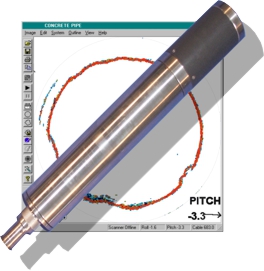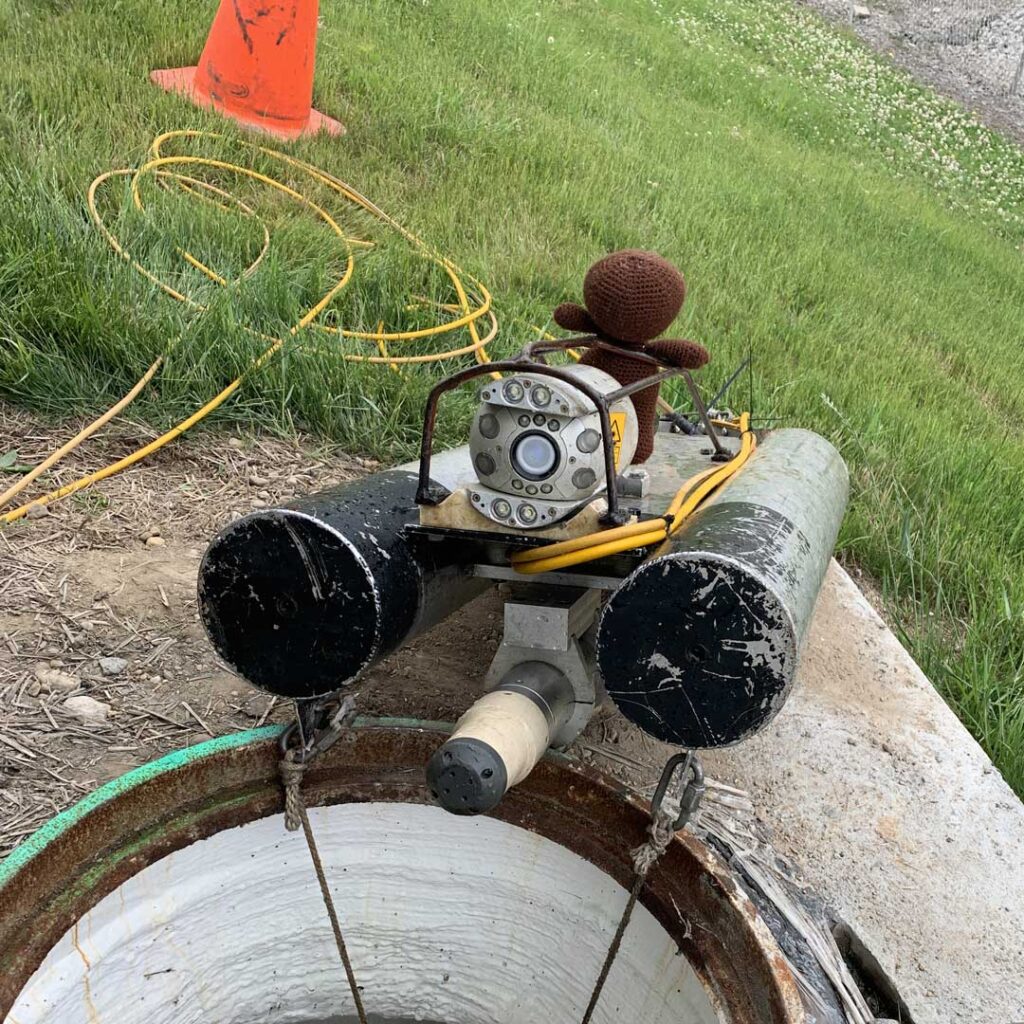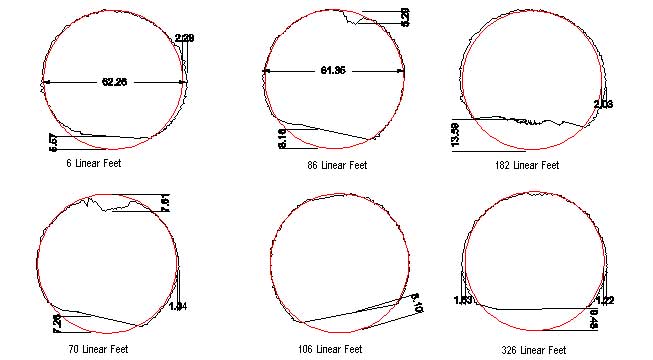Sonar Pipe Profiling
Inspection Of Surcharged or Partially Filled Pipelines

R&R Visual utilizes this unique inspection instrument to fill a void left by conventional video inspection. In the past, pipelines and ducts filled with murky water have been left un-inspected due to the high cost and potential down time involved with the process. As pipelines around the world are deteriorating, it has become a necessity to inspect these subsurface time bombs. With sonar pipeline profiling, this task has become amazingly fast and affordable, while achieving outstanding results. We have integrated this instrument with R&R Visual’s proprietary software, allowing three-dimensional modeling of subsurface pipelines, shafts, and ducts, as well as real time measurement or defects, pipe size, and debris.
As the scanner is moved through the pipe an indication of the distance traveled is shown on the screen allowing for accurate determination of the location of defects in the pipe. Internal sensors monitor and display Pitch and Roll indicators in analogue and digital form on the screen to show the orientation of the transducer unit.
Combining Sonar & CCTV (Multisensor)
Sonar and CCTV are both useful tools in the underground inspection world, but when combined together, they can provide incomparable deliverables.
The sonar images will be superimposed onto the CCTV image when both inspections are completed together. Generally CCTV combined with sonar is used for internal condition assessment where depth of flow of sewage varies from 25% to 75% of overall sewer diameter for sewers greater than 24-inches in diameter. Where the sewer is less than 24-inches in diameter and depth of flow of sewage exceeds 25% and is less than 75% of overall sewer diameter the operator on site will make the decision to continue the inspection or utilize one inspection method.
R&R Visual, Inc. is considered one of the leading innovators in the sonar/CCTV inspection field. Our technicians have each logged many miles of inspection, and our unique reporting options insure that you will receive useful, accurate sonar data.

Capabilities & Reporting
The sonar head must be submerged below water for the resonator to be active. As long as the head is submerged, profiles of the entire pipeline diameter can be gathered regardless of flow height. Profiles of pipe taken through air, will be exaggerated measurements due to the speed of sound through air, as compared to water.
The sonar resonator must be a minimum of 5 inches away from object it will profile. This determines the minimum pipe size of 10 inch, however 12 inch is recommended if debris or protrusions are thought to exist.
Defects recognition is based on whether sound can pass through the defect. If an open break, greater than 3mm in width, is present the sonar will locate this defect. However, if the break is not open or is cracked the sonar will not see this because sound will not pass through it. This same concept allows our operators to measure debris and sediment depth in pipeline and shafts.
The only known limitations of the sonar profiling unit is high concentrations of suspended solids in the water filling the pipelines. For example, paper pulp waste is too dense for the sonar signal to pass through and reflect off of the pipe walls.
Sonar Profiling Reporting
R&R Visual makes every report package, for every service, user friendly, and easy to read. Sonar profiling opens many doors for reporting possibilities. With the unique aspect of acquiring data in a measurement format, profiles can be plotted in a three dimensional plane. Information about profile location will give us the X and Y coordinates, and the footage from the entry point gives us the Z coordinate. This method allows us to not only supply hard copy report, but also supply electronic reporting that can be opened in almost any computer aided design software. Opening the report in such software allows the customer to take additional measurements or view each profile independently.
R&R has also provided customer with customized reports to better suit their needs. For an inspection where debris and sediment location is the goal, we can supply a report showing the profile of the sediment for the entire lateral length. With the assistance of R&R Visual’s computer programming department, we can generate nearly any report that you desire. All reports are supplied in a hard copy format, as well as on a CD-ROM in an electronic format. We support all popular computer formats available today.
Frequently Asked Questions
If you have a pipe that is filled or partially filled with fluid, the sonar profiler will inspect the fluid filled sections of the pipe. For partially filled pipes, R&R can utilize video or the air filled section of the pipe and sonar for the fluid filled section.
Sonar measures the geometry of the pipe at a specific section, as if you sliced the pipe and looked at the open end. All of the slices can be put together to generate a 3D model of pipeline.
The number of profiles is dependent on the speed of which the sonar is traveling through the pipe segment. It takes around 1.2 seconds to generate a 360 degree profile of the pipe wall. The speed and density of these profiles is determine by what the customer is looking for in the pipe segment. Debris measurement, for example, takes very few profiles, while locating a protrusion or dents many take many.
No, and anyone who says they can, does not understand sonar technology. In general, sonar sends out a sound pulse and measures the time it takes to get a echo back. The sound waves grows larger the further away from the transducer and will echo off of any solid object and return the distance. As an example, in a 48″ diameter pipeline, the sound pulse will sample a 2″ diameter area on the pipe wall and return the distance.
Yes, but rarely, unless it is a large hole. This is also dependent on the diameter of the pipe. Due to time it takes to create a profile (1.2 seconds) and the diameter of the reflected sound sample, it is rare to find holes in a pipe.
There are many uses, however the most popular are calculating the debris volume in interceptors, inspecting siphons, verifying diameter or calculating erosion / corrosion, and measuring ovality.
There are several variables that need to be taken into consideration when performing sonar profiling services. The temperature of the fluid is one main concern. The warmer the fluid, the faster sound can travel through it. Flow is another consideration, as extremely high flows can carry the sound away before it is echoed back to the transducer. These cases are rare, but our solution specialist can assist in further questions.
R&R Visual utilizes wheeled robotics, floating rafts, and skid assemblies to transport the sonar profiler through the pipeline. The method is dependent on diameter of pipe, flow, and if there is a change of direction (bends or elbows)
Absolutely! R&R has decades of experience inspecting vertical shafts, drilled shafts, inverts and other vertical applications. Our technology even allows us to profile through drilling fluids. With our vertical shaft modeling, we can even tell surface wall roughness and verticality.
When thinking of multi-sensor inspection, we look at video, laser profiling, and sonar profiling… all done at once. Each of these inspections are actually done differently and by trying to do them all at once, make 1, 2, or even all 3 technologies subpar. With sonar you want to move slowly through the pipe, and at a consistent speed. With video you want to stop – pan, tilt, and even zoom in on the pipe wall to get detailed information. With laser, you want to move rather quickly through the pipe at a constant speed. Don’t be oversold by packaging all these technologies into one pass through the pipe segment…

